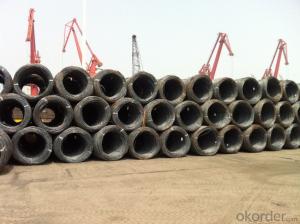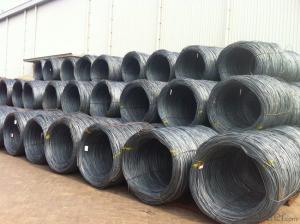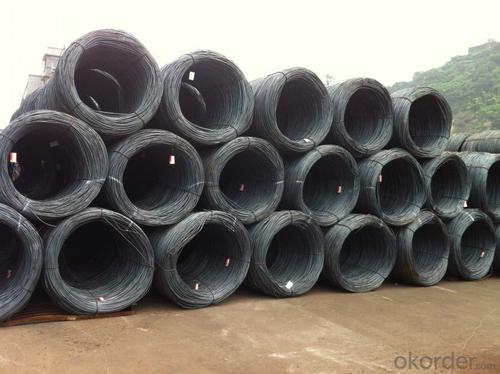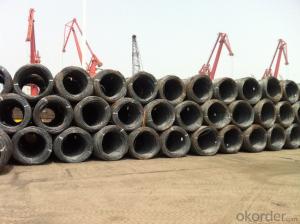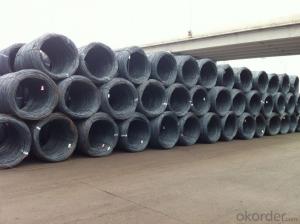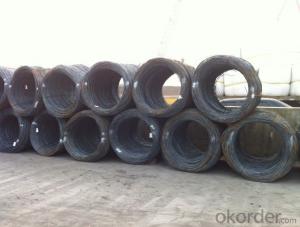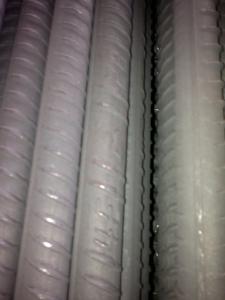Wire rod SAE 1006-1008 with highest quality and best price
- Loading Port:
- Tianjin
- Payment Terms:
- TT OR LC
- Min Order Qty:
- 25 m.t.
- Supply Capability:
- 10000 m.t./month
OKorder Service Pledge
OKorder Financial Service
You Might Also Like
Product Description:
OKorder is offering high quality wire rods at great prices with worldwide shipping. Our supplier is a world-class manufacturer of steel, with our products utilized the world over. OKorder annually supplies products to European, North American and Asian markets. We provide quotations within 24 hours of receiving an inquiry and guarantee competitive prices.
Product Applications:
After hot-rolled the products shaped into coil and delivery as finished product, including round, square, rectangular, hexagonal and so on, Since most of the products are round, it is generally called wire rod. Steel wire rod is widely used in construction and manufacturing. Steel wire rod is mainly used for reinforcement of reinforced concrete and welded structure or reprocessed (roberts, nail etc) materials, especially used to produce wire drawing, welding electrode, nails,spring, electronic, precise machinery parts and so on.
Product Advantages:
OKorder's wire rods are durable, strong, and resist corrosion.
Main Product Features:
· Premium quality
· Prompt delivery & seaworthy packing (30 days after receiving deposit)
· Corrosion resistance
· Can be recycled and reused
· Mill test certification
· Professional Service
· Competitive pricing
Product Specifications:
Manufacture: Hot rolled
Grade: SAE1006-1018
Certificates: ISO, SGS, BV, CIQ
Packaging: Export packing, nude packing, In Coils
Grade | Chemical Composition (%) | |||||
C | Mn | S | P | Si | B | |
SAE1006B | 0.03~O.07 | 0.32max | 0.045max | 0.040max | 0.30max | 0.0008min |
Mechanical properties | ||||||
Yield strength(N/mm2) | Tensile strength(N/mm2) | Elongation (%) | ||||
250-280 | 350-380 | ≥32 | ||||
Grade | Chemical Composition (%) | |||||
C | Mn | S | P | Si | B | |
SAE1008B | 0.10max | 0.3~0.50 | 0.050max | 0.040 max | 0.15max | 0.0008 min |
Mechanical properties | ||||||
Yield strength(N/mm2) | Tensile strength(N/mm2) | Elongation (%) | ||||
≥195 | 315-430 | ≥30 | ||||
FAQ:
Q1: Why buy Materials & Equipment from OKorder.com?
A1: All products offered byOKorder.com are carefully selected from China's most reliable manufacturing enterprises. Through its ISO certifications, OKorder.com adheres to the highest standards and a commitment to supply chain safety and customer satisfaction.
Q2: How do we guarantee the quality of our products?
A2: We have established an advanced quality management system which conducts strict quality tests at every step, from raw materials to the final product. At the same time, we provide extensive follow-up service assurances as required.
Q3: How soon can we receive the product after purchasing ?
A3: Within three days of placing an order, we will begin production. The specific shipping date is dependent upon international and government factors, but is typically 7 to 10 workdays.
Images:
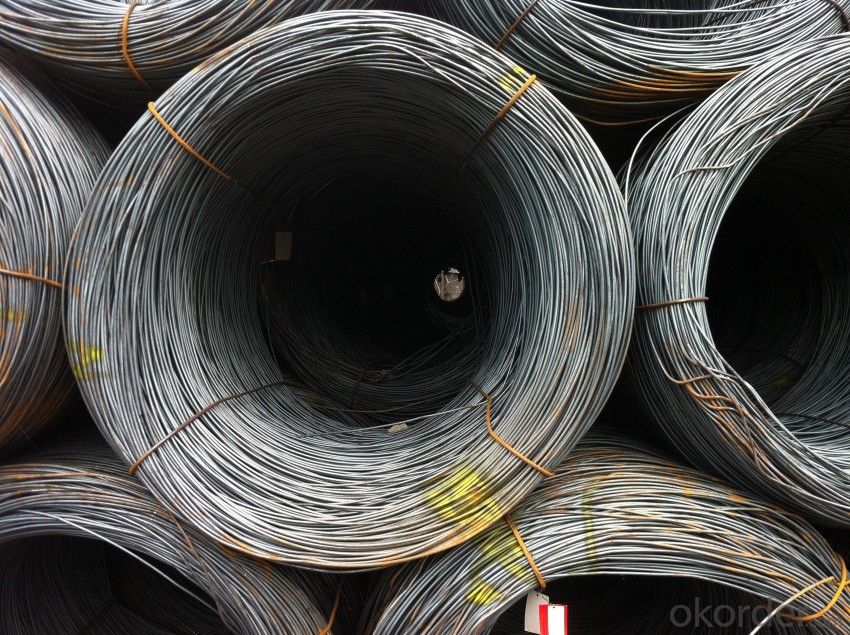

- Q: What are the different hardness measurement methods for steel wire rod?
- There are several different methods used to measure the hardness of steel wire rods. These methods include: 1. Rockwell Hardness Test: This test measures the depth of penetration of an indenter into the material under a specified load. The Rockwell hardness scale is commonly used for steel wire rods due to its simplicity and versatility. 2. Brinell Hardness Test: In this test, a hardened steel ball is pressed into the surface of the wire rod under a known load. The hardness is determined by measuring the diameter of the indentation left by the ball. 3. Vickers Hardness Test: This test uses a square-based pyramid-shaped diamond indenter to make an indentation on the surface of the wire rod. The size of the indentation is measured and used to calculate the hardness. 4. Knoop Hardness Test: Similar to the Vickers test, the Knoop test uses a rhombic-based pyramid-shaped diamond indenter. It is particularly suitable for measuring the hardness of thin materials. 5. Microhardness Testing: This method involves measuring the hardness of small regions or specific areas on the wire rod using a microscope. It is often used to study the microstructure and hardness variations within the material. It is important to note that each hardness measurement method has its own advantages and limitations. The choice of method depends on the specific requirements and characteristics of the steel wire rod being tested.
- Q: How is the diameter of a steel wire rod determined?
- The diameter of a steel wire rod is typically determined using a measuring instrument, such as a micrometer or caliper, which allows for precise measurements. The instrument is applied to the wire rod at multiple points along its length, and the average diameter is calculated based on these measurements.
- Q: How is steel wire rod used in the production of suspension springs for aircraft?
- Steel wire rod is used in the production of suspension springs for aircraft as it provides the necessary strength, durability, and flexibility required to withstand the high stress and load-bearing requirements of the springs. The wire rod is first shaped into the desired spring form, and then heat-treated and tempered to enhance its mechanical properties. This ensures that the suspension springs can effectively absorb and distribute forces, providing stability and smooth operation to the aircraft during takeoff, landing, and flight.
- Q: How is steel wire rod used in the manufacturing of wire mesh conveyor belts?
- Steel wire rod is used in the manufacturing of wire mesh conveyor belts as it serves as the primary material for the production of wire mesh. The wire rod is drawn into thin wires, which are then woven together to form a mesh pattern. This mesh structure provides strength, flexibility, and durability to the conveyor belts, allowing them to withstand heavy loads and high temperatures commonly encountered in industrial applications. Additionally, the steel wire rod's corrosion resistance and high tensile strength make it an ideal choice for constructing conveyor belts that can efficiently transport materials in various industries such as mining, food processing, and automotive manufacturing.
- Q: What are the standard cleanliness requirements for steel wire rod?
- The standard cleanliness requirements for steel wire rod typically include the absence of surface defects such as scale, rust, or pitting. It should also be free from any contaminants like dirt, oil, or grease. Additionally, the wire rod should meet specific chemical composition and mechanical properties as per industry standards or customer specifications.
- Q: What are the different types of steel wire rod coatings used for lubrication?
- There are several types of steel wire rod coatings used for lubrication, including zinc coatings, copper coatings, and phosphate coatings. Zinc coatings, such as galvanization, provide corrosion resistance and lubricity. Copper coatings offer enhanced lubrication and thermal conductivity. Phosphate coatings, on the other hand, provide excellent adhesion and anti-wear properties.
- Q: How is steel wire rod used in the production of nails and fasteners?
- Nails and fasteners heavily rely on steel wire rod, a fundamental element in their manufacturing process. Serving as the main raw material, it grants the necessary strength and durability to these items. To create nails and fasteners, steel wire rod undergoes a series of carefully planned procedures. Initially, it is heated and rolled into a coil shape, enhancing its ductility and reducing its thickness. This procedure, known as hot rolling, imparts the wire rod with the essential properties required for subsequent manipulation. Following hot rolling, the wire rod goes through cold drawing, where it is pulled through a set of dies to further decrease its diameter. This process not only improves the wire's surface finish but also enhances its mechanical properties, including tensile strength and hardness. Upon completion of cold drawing, the drawn wire is cut into specific lengths, depending on the desired size of nails or fasteners. These lengths are then fed into either a nail making machine or a fastener production line. In the case of nails, the wire is passed through a cutter that shapes the nail heads and points. Conversely, for fasteners, the wire is molded and formed into the desired product, such as screws, bolts, or rivets. The quality of the steel wire rod utilized in the production of nails and fasteners is of utmost importance for the performance of the end products. It must possess exceptional tensile strength, as nails and fasteners are subjected to significant stresses during use. Moreover, the wire rod needs to exhibit corrosion resistance, ensuring that the nails and fasteners can endure exposure to moisture and other environmental conditions without deterioration. All in all, steel wire rod assumes a crucial role in the production of nails and fasteners, providing the indispensable strength, durability, and corrosion resistance necessary for these essential commodities.
- Q: How is steel wire rod used in the production of wire mesh for automotive applications?
- Steel wire rod is used in the production of wire mesh for automotive applications by being drawn through a series of dies to reduce its diameter and increase its length. This process, known as wire drawing, results in a thin and elongated wire that is then woven or welded to create wire mesh. The wire mesh is then utilized in various automotive applications such as reinforcing structures, providing protection, or acting as a filtration system.
- Q: How is steel wire rod recycled at the end of its lifecycle?
- Steel wire rod can undergo steel scrap recycling at the end of its lifecycle. This involves a number of steps to transform the wire rod into reusable steel materials. To begin the recycling process, steel wire rod scraps are collected from various sources such as manufacturing waste, construction materials, or end-of-life products like old cars or appliances. Once collected, the scraps are sorted and separated based on their composition and quality. The sorted steel wire rod scraps are then sent to a recycling facility where they are shredded into smaller pieces to facilitate further processing. Shredding can be done using different methods, such as hydraulic shears or industrial shredders. After shredding, the steel wire rod pieces undergo magnetic separation to remove any non-ferrous materials like plastic or rubber that may be mixed with the scraps. Magnetic separators attract and remove these non-ferrous materials, leaving behind the steel wire rod pieces. The separated steel wire rod pieces are further processed to remove impurities or contaminants. This is done through a process called melting, where the wire rod pieces are heated to extremely high temperatures in a furnace. This melting process burns off or skims off any impurities or contaminants from the molten metal. Once the impurities are removed, the molten steel is poured into molds to form new steel products. The molds can vary depending on the desired shape and size of the final product. After the steel has solidified, it can be further processed and treated to meet specific requirements, such as tempering or strengthening. The recycled steel wire rod can be used as raw material in industries like construction, automotive manufacturing, and appliance production. This reduces the need for extracting and refining virgin iron ore, which conserves natural resources and minimizes environmental impact. In conclusion, steel wire rod is recycled through a series of steps including collection, sorting, shredding, magnetic separation, melting, molding, and further processing. This process allows the steel to be reused in various industries, promoting sustainability and reducing the demand for new steel production.
- Q: What are the different surface defects that can impact the bending properties of steel wire rod?
- There are several surface defects that can impact the bending properties of steel wire rods. Some common defects include cracks, pits, scale, scratches, and uneven surface texture. These defects can affect the structural integrity of the wire rod, making it more prone to breakage or deformation during bending. It is important to carefully inspect and address these defects to ensure the desired bending properties of the steel wire rod.
Send your message to us
Wire rod SAE 1006-1008 with highest quality and best price
- Loading Port:
- Tianjin
- Payment Terms:
- TT OR LC
- Min Order Qty:
- 25 m.t.
- Supply Capability:
- 10000 m.t./month
OKorder Service Pledge
OKorder Financial Service
Similar products
Hot products
Hot Searches
Related keywords

